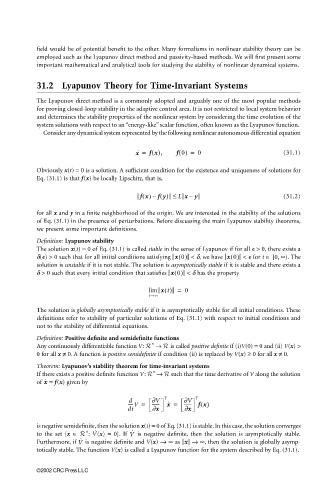Page 939 - The Mechatronics Handbook
P. 939
0066_frame_C31.fm Page 2 Wednesday, January 9, 2002 7:49 PM
field would be of potential benefit to the other. Many formalisms in nonlinear stability theory can be
employed such as the Lyapunov direct method and passivity-based methods. We will first present some
important mathematical and analytical tools for studying the stability of nonlinear dynamical systems.
31.2 Lyapunov Theory for Time-Invariant Systems
The Lyapunov direct method is a commonly adopted and arguably one of the most popular methods
for proving closed-loop stability in the adaptive control area. It is not restricted to local system behavior
and determines the stability properties of the nonlinear system by considering the time evolution of the
system solutions with respect to an “energy-like” scalar function, often known as the Lyapunov function.
Consider any dynamical system represented by the following nonlinear autonomous differential equation
x ˙ = fx(), f 0() = 0 (31.1)
Obviously x(t) = 0 is a solution. A sufficient condition for the existence and uniqueness of solutions for
Eq. (31.1) is that f(x) be locally Lipschitz, that is,
fx() fy() ≤ L xy (31.2)
–
–
for all x and y in a finite neighborhood of the origin. We are interested in the stability of the solutions
of Eq. (31.1) in the presence of perturbations. Before discussing the main Lyapunov stability theorems,
we present some important definitions.
Definition: Lyapunov stability
The solution x(t) = 0 of Eq. (31.1) is called stable in the sense of Lyapunov if for all > 0, there exists a
δ( ) > 0 such that for all initial conditions satisfying x 0() < δ, we have x 0() < for t ∈ [0, ∞). The
solution is unstable if it is not stable. The solution is asymptotically stable if it is stable and there exists a
δ > 0 such that every initial condition that satisfies x 0() < δ has the property
lim x t() = 0
t→∞
The solution is globally asymptotically stable if it is asymptotically stable for all initial conditions. These
definitions refer to stability of particular solutions of Eq. (31.1) with respect to initial conditions and
not to the stability of differential equations.
Definition: Positive definite and semidefinite functions
Any continuously differentiable function V: R → R is called positive definite if (i)V(0) = 0 and (ii) V(x) >
n
0 for all x ≠ 0. A function is positive semidefinite if condition (ii) is replaced by V(x) ≥ 0 for all x ≠ 0.
Theorem: Lyapunov’s stability theorem for time-invariant systems
n
If there exists a positive definite function V: R → R such that the time derivative of V along the solution
of = f(x) given byx ˙
d
------- fx()
-----V = ∂V T x ˙ = ∂V T
-------
dt ∂x ∂x
is negative semidefinite, then the solution x(t) = 0 of Eq. (31.1) is stable. In this case, the solution converges
n
to the set {x ∈ R : (x) = 0}. If is negative definite, then the solution is asymptotically stable.V ˙ V ˙
˙
V
Furthermore, if is negative definite and V(x) → ∞ as x → ∞, then the solution is globally asymp-
totically stable. The function V(x) is called a Lyapunov function for the system described by Eq. (31.1).
©2002 CRC Press LLC

